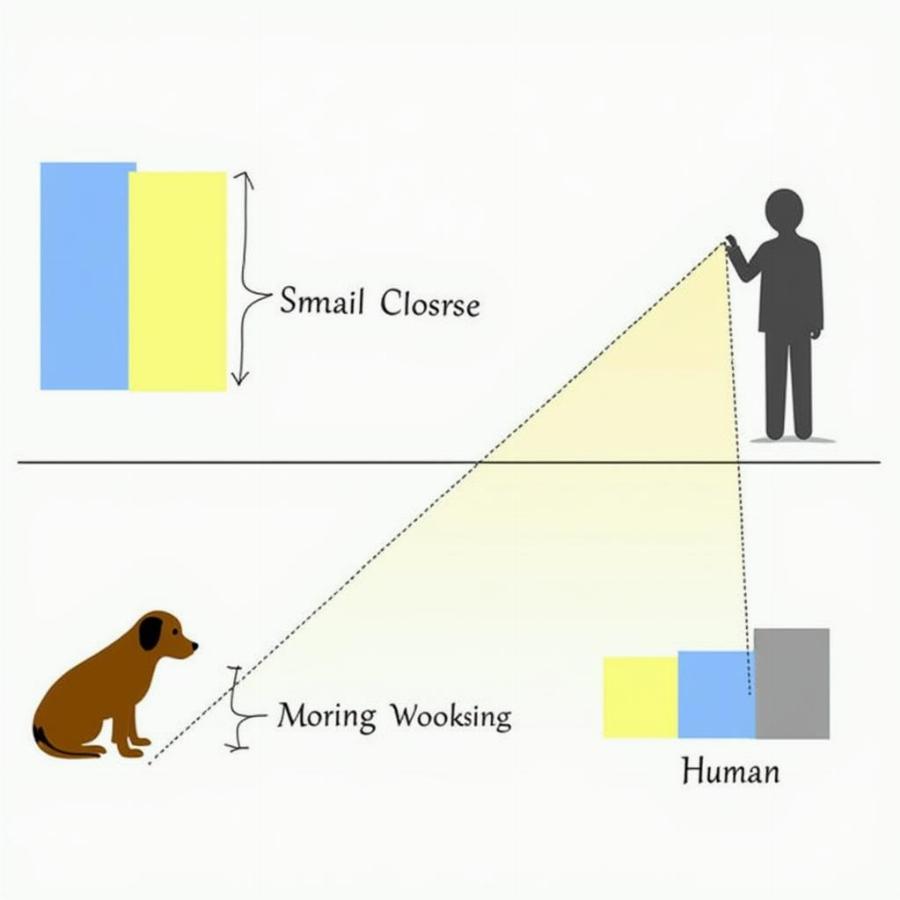Do dogs have a favorite color? It’s a question that has intrigued dog lovers for years. While we may associate certain colors with our furry friends, the reality of canine color vision is quite different from our own. Understanding how dogs see color can help us choose toys, bedding, and even training tools that are more appealing and engaging for them. This article delves into the science behind dog vision, debunking common myths and revealing what colors dogs actually perceive.
How Dogs See the World: A Different Perspective
Unlike humans who have trichromatic vision (seeing red, green, and blue), dogs have dichromatic vision, similar to humans with red-green colorblindness. This means their color spectrum is limited, primarily seeing shades of blue, yellow, and gray. So, while we see a vibrant rainbow, our canine companions perceive a more muted palette. Thinking your dog is drawn to that bright red ball? They’re likely more interested in its shape and movement than its color.
 Dog Perceiving Yellow, Blue, and Gray
Dog Perceiving Yellow, Blue, and Gray
Do Colors Matter to Dogs?
While dogs see a limited range of colors, that doesn’t mean color is irrelevant to them. Studies have shown that dogs can distinguish between different colors within their limited spectrum. For instance, they can differentiate between blue and yellow, but they may confuse red and green, perceiving both as shades of gray. Therefore, selecting toys and accessories in shades of blue or yellow might make them more noticeable and appealing to your dog.
Choosing the Right Hues for Your Hound: Practical Tips
So, what are the practical implications of understanding your dog’s color vision? Consider these tips when selecting items for your furry friend:
- Toys: Opt for blue or yellow toys, particularly for fetch or training. Realistic plush dog can be engaging, but choose one in a color they can easily distinguish.
- Bedding: While aesthetics are important for us, your dog is less concerned with matching their bed to your decor. Choose a comfortable bed in a neutral or blue/yellow shade.
- Training Tools: For agility or obedience training, using blue or yellow markers can be more effective than red or green.
Debunking the Myth of “Dogs Only See Black and White”
One common misconception is that dogs only see in black and white. This is simply not true. Their dichromatic vision allows them to perceive a range of colors, albeit a smaller one than humans. While they don’t experience the vibrancy of a red sunset, they can still appreciate the difference between a blue sky and a yellow tennis ball.
Beyond Color: Other Factors Influencing Dog Vision
Color isn’t the only factor determining how dogs see the world. They excel in low-light conditions due to a higher number of rods in their eyes, which are responsible for detecting light and motion. They also have a wider field of vision than humans, allowing them to perceive more of their surroundings. So, while they may not see the full spectrum of colors, their visual abilities are finely tuned for other crucial aspects of their environment.
What About Colorblind Dogs?
While all dogs have dichromatic vision, some dogs may experience variations in their color perception, similar to different types of colorblindness in humans. However, this is generally less common and doesn’t significantly alter their overall vision.
“Understanding a dog’s visual perspective is key to enhancing their interaction with the world,” says Dr. Emily Carter, a veterinary ophthalmologist. “Choosing appropriate colors for toys and training tools can significantly improve their engagement and enjoyment.”
Conclusion: Seeing the World Through Your Dog’s Eyes
So, what is a dog’s favorite color? The answer is likely less about a specific hue and more about contrast and visibility within their limited color spectrum. By understanding how dogs perceive color, we can make informed choices about the items we provide for them, creating a more enriching and stimulating environment. Paint by numbers dogs might be a fun activity for you, but remember to choose colors your dog can actually see! Choosing toys and accessories in shades of blue and yellow, considering their other heightened visual abilities, allows us to better cater to their unique perception of the world.
FAQ:
- Do dogs see better than humans in the dark? (Yes, due to more rods in their eyes)
- Can dogs see the color red? (No, they see it as a shade of gray)
- What colors are most stimulating for dogs? (Blue and yellow)
- Is it true that dogs only see black and white? (No, this is a myth)
- How does a dog’s vision differ from a human’s? (Dichromatic vs. trichromatic)
- What should I consider when choosing toys for my dog? (Color, shape, and texture)
- Can dogs be colorblind? (Variations in color perception can occur)
Further Questions to Explore:
- Dog Vision and Breed Differences
- The Impact of Color on Dog Training
- Designing Dog-Friendly Environments with Color in Mind
Beaut Dogs is your trusted source for all things canine, providing expert advice and guidance on dog care, breeds, and much more. For any assistance, contact Email: [email protected] to receive detailed and accurate answers from Beaut Dogs. https://beautdogs.com Hot dog blow up can be fun for celebrations, but always prioritize your dog’s safety with appropriate toys. Can dogs eat jello? Find out on our site! Dogs of disney dooney and bourke are collectible, but your real dog deserves the best care, and we can help you provide that.